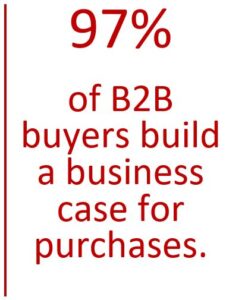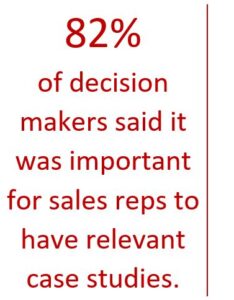ROI Business Cases Help Differentiate During Economic Uncertainty
In times of economic uncertainty, business executives look for increased clarity and confidence to support significant investments. In 2019, Forrester commissioned a survey of 747 technology buying decision makers at global enterprises to identify marketing and sales content preferences. Decision makers indicated that a business case is the most useful format to get information and content when making a technology purchasing decision.

In that survey, 97% reported using a business case to justify purchases. They want insight into how their peers are facing similar challenges and a clear demonstration of business value.
Many marketing and sales teams think that a business case to justify investment is out of their control — viewing it as an inevitability rather than an opportunity. Companies selling products or services can accelerate decision making and increase win rates. Specifically, marketing teams can create messages that anticipate business case needs, and sales reps can address the value story, peer examples, and ROI during the sales cycle.
In Forrester’s survey, 82% of technology buying decision makers said that it is “important or very important” for sales reps to have relevant examples or case studies to share with them. In other words, companies can build competitive advantage by anticipating and accelerating business-case justification with buyers.
By this, do we mean a spreadsheet with a hundred tabs, linked sheets, and formulas that demonstrate financial wizardry and examine every possible calculation? Absolutely not. Instead, Forrester helps companies simplify their value story rather than obscure the message within a matrix of cumbersome calculations.
Here’s how you can do that. As you think about your products and services, ask:
- What are the benefits that buyers typically realize by using your company’s products?
- How does your product improve a buyer’s customer experience, increase its revenue, or accelerate its time-to-market?
- How does your product mitigate risk or enhance business resiliency for the buyer organization?
- How does your product improve operational costs or enhance employee productivity?
- What is the future value of your product if a buyer invests today instead of waiting until later?
At Forrester, we call these attributes the Total Economic Impact:
Total Economic Impact (TEI) is Forrester’s methodology for measuring the value that buyers realize from a solution.
While buyers will build their own internal business case, technology marketers and sellers have an opportunity to influence that business case. Buyers value objective case studies that outline the business value realized by existing customers. Buyers value insights from unbiased, objective sources. And buyers value anecdotes, examples, and transparent calculations. Simply put, marketers should build content marketing that is value-based and quantitative rather than feature-oriented.
In Forrester’s 2019 content preferences survey, buyers highlighted the information or content that they find most valuable when making a purchase:

- 41% prefer peer case studies containing stories or facts.
- 41% want studies that show ROI and business-impact statistics.
- 46% indicated that they want to measure business impact, such as customer experience.
- 49% want a study to include softer metrics such as employee productivity.
- 69% value studies from credible, third-party sources.
The next step in your journey may be a Forrester TEI study. To discuss how Forrester could quantify and convey the value of your specific solution, send us a note at teiconsulting@forrester.com. To read more about Forrester, the TEI methodology, and how to start developing your own ROI-based content marketing assets, you can read Where To Start Your Business Case by Veronica Iles or Measuring Business Value Is Within Your Reach by Sean Owens, or track the ongoing discussion about measuring value on this page.
